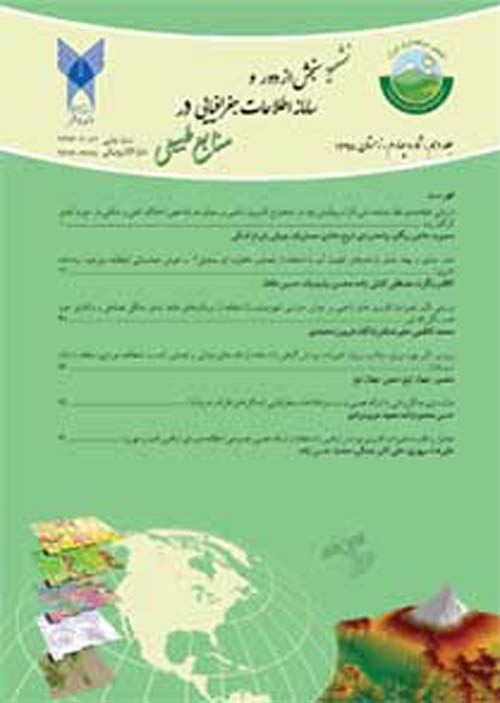Identifying Origins of Atmospheric Aerosols using Remote Sensing and Data Mining (Case study: Yazd province)
Background and Objective:
The Middle East is one of the most important regions in the world for dust production. Iran, located in the Middle East, is exposed to numerous local and trans-regional dust systems due to its location in the arid and semi-arid regions of the world. Dust storms, in addition to covering arable land and plants with wind-blown materials, destroy fertile lands and reduce biological production and biodiversity, and severely affect the survival of residents. Dust storms are involved in the transmission of dangerous pathogens to humans, air pollution, and damage to respiratory function. Dust storms in Yazd province are relatively common and the average number of days with dust storms in the province reaches 43 days a year. This phenomenon has caused many problems for the people of the province. The main indicators of air quality are the concentration of suspended particles and the aerosol optical depth (AOD) following the occurrence of dust events. Numerous studies have been conducted in the world to identify the centers of dust collection and their origin. However, to the best of the authors’ knowledge, there is no study on the spatial zoning of dust conditions using three algorithms of CART, MARS and TreeNet algorithms as the predictive models. The purpose of this study is to forecast and zoning the potential of different areas for the production of dust aerosols using remote sensing data and data mining models as well as to specify the most important variables on this phenomenon in Yazd province.
Materials and Methods:
The Yazd province lies in a dry region of Central Iran. The province experienced average annual rainfall of about 57 mm and an average annual temperature of about 20 ºC. The maximum temperature experienced in the warmest month of the province is close to 46 ºC. The maximum wind speed in this province is up to 120 kilometres per hour. The Google Earth Engine (GEE) interface (Javascript editor) was applied to collect remote sensing data in order to form three data sets that contain features related to topography, climate, and land surface conditions. These features were employed as the independent variables of the models, which is built by taking advantage of three data mining algorithms, classification and regression tree (CART), multivariate adaptive regression splines (MARS), and TreeNet, to specify the potential of areas for dust production. The dependent variable (target variable) of the models was the aerosol optical depth (AOD), which was acquired from MOD04 AOD retrievals from the Moderate Resolution Imaging Spectroradiometer (MODIS) onboard NASA's Terra satellite. The outcomes of the three models for classifying areas with different dust potentials were evaluated under performance criteria, such as R-squared, mean absolute deviation (MAD), the mean square error (MSE), the mean relative absolute deviation (MRAD), and the root means square error (RMSE).
Results and Discussion :
The results showed the variables mostly affecting the dependent variable (AOD) in the MARS model were actual evapotranspiration, soil moisture, and the Palmer drought severity index. The values of R2 and RMSE in the MARS model were equal to 0.72 and 0.02, respectively. Similarly, the features with the highest relative importance according to the TreeNet model were soil moisture, Palmer drought severity index, and actual evapotranspiration. The values of R2 and RMSE in the TreeNet model were equal to 0.75 and 0.019, respectively. The results revealed that the CART model with R2 =0.85, MAD = 0.011, MSE =0.002, MRAD =0.262, and RMSE =0.014 had the best performance compared with the other two data mining models. The soil moisture, elevation, reference and actual evapotranspiration, minimum and maximum temperature, Palmer drought severity index, downward shortwave solar radiation, and wind speed were the most important variables in forecasting the potential of areas for dust production, respectively. Also, the areas with very high, high, moderate, low and very low susceptibility were occupied about 16%, 19%, 26%, 20% and 20% of the Yazd province, respectively.
Conclusion :
All three models, which were based on three data mining algorithms, CART, MARS, and TreeNet, had a good agreement in specifying the most important variables affecting the optical depth of the dust aerosols in the study area. However, these models indicated different priority order for the identified variables in terms of relative importance; Besides, there was a difference in their performance criteria. As mentioned above, the CART model was the best-performing model, of the current study, for specifying the potential of areas for the generation of dust aerosols. According to this model, 25.8% of the province was classified as the moderate-risk of aerosol production, 18.6% of the province as the high-risk of aerosol production, and 16.0% of the study region as the very high-risk of dust aerosols. The high-risk areas are mostly spread in the western and southwestern regions of the Yazd province.
Palmer United States golfer (born in 1929) More (Definitions, Synonyms, Translation).
-
Investigating the Effect of Check Dams on Flood Hydrograph in an Ungauged Watershed (Case study: Kander Abdolreza, Fars province)
Alireza Nafarzadegan*, Mohamad Kazemi, Masoud Samiee
Iranian Journal of Watershed Management Science and Engineering, -
Determining Effective Factors Regarding Weather and Some Types of Air Pollutants in Seasonal Changes of PM10 Concentration Using Tree-Based Algorithms in Yazd City
Zohre Ebrahimi-Khusfi, Mohsen Ebrahimi-Khusfi, *, Mojtaba Soleimani-Sardo
Journal of Environmental Health and Sustainable Development, Mar 2024 -
Design of a type of optical optical spectrometer in the UV- A spectral region
Ali Rezaei-Latifi *
Journal of Applied Electromagnetic, -
Design of a Three-Element Apochromatic Lens to Correct Axial Chromatic Aberration at UVA Wavelength Band
Ali Rezaei- Latifi *
Journal of Optoelectronical Nanostructures, Autumn 2023



